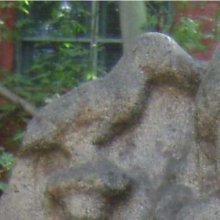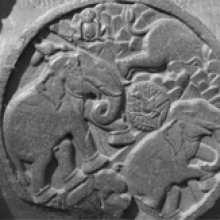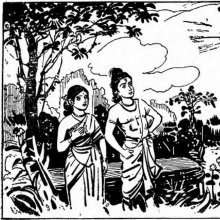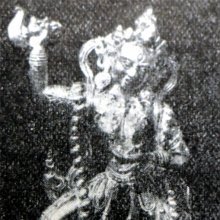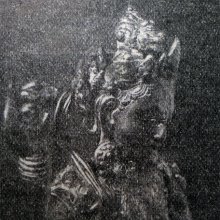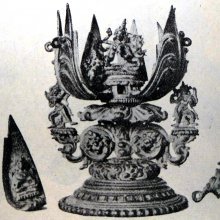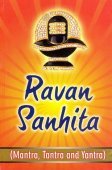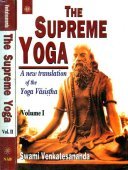Crow: 3 definitions
Introduction:
Crow means something in Buddhism, Pali, Hinduism, Sanskrit. If you want to know the exact meaning, history, etymology or English translation of this term then check out the descriptions on this page. Add your comment or reference to a book if you want to contribute to this summary article.
Images (photo gallery)
(+4 more images available)
In Hinduism
Shilpashastra (iconography)
Source: Shodhganga: Elements of Art and Architecture in the Trtiyakhanda of the Visnudharmottarapurana (shilpa)Crows are associated with the Winter Season, which follows specific guidelines of ancient Indian Painting (citra), according to the Viṣṇudharmottarapurāṇa, an ancient Sanskrit text which (being encyclopedic in nature) deals with a variety of cultural topics such as arts, architecture, music, grammar and astronomy.—The Viṣṇudharmottarapurāṇa gives some instructions to make the picture of every season beautiful and natural. The winter season (śiśira) should be depicted through the picture having pleased crows and elephants and a person shivering in cold. According to the Viṣṇudharmottarapurāṇa the picture should contain horizon filled with snow. [...] Thus, the Viṣṇudharmottarapurāṇa addresses various elements of nature, such as crows in the winter season, since painting has much connection with time, mood and activity.

Shilpashastra (शिल्पशास्त्र, śilpaśāstra) represents the ancient Indian science (shastra) of creative arts (shilpa) such as sculpture, iconography and painting. Closely related to Vastushastra (architecture), they often share the same literature.
Yoga (school of philosophy)
Source: ORA: Amanaska (king of all yogas): A Critical Edition and Annotated Translation by Jason BirchThe Crow (bird) is denoted by the Sanskrit term Kāka, according to the Amanaska Yoga treatise dealing with meditation, absorption, yogic powers and liberation.—Accordingly, as Īśvara says to Vāmadeva: “[...] As long as the highest reality is not known, the mind is unrestrainable. However, when the highest reality is known, the mind becomes [still] like a crow [perched] on the mast of a ship (naustambha-kākavat). [...]”.

Yoga is originally considered a branch of Hindu philosophy (astika), but both ancient and modern Yoga combine the physical, mental and spiritual. Yoga teaches various physical techniques also known as āsanas (postures), used for various purposes (eg., meditation, contemplation, relaxation).
In Buddhism
Tibetan Buddhism (Vajrayana or tantric Buddhism)
Source: academia.edu: The Structure and Meanings of the Heruka MaṇḍalaThe Crow is associated with the Yoginī (female deity) named Kākī, being situated in the Vāyucakra, according to the 10th century Ḍākārṇava-tantra: one of the last Tibetan Tantric scriptures belonging to the Buddhist Saṃvara tradition consisting of 51 chapters.—Accordingly, the vāyucakra refers to one of the three divisions of the dharma-puṭa (‘dharma layer’), situated in the Herukamaṇḍala. The 36 pairs of Ḍākinīs [viz., Kākī—“Crow”] and Vīras are dark blue in color; they each have one face and four arms; they hold a skull bowl, a skull staff, a small drum, and a knife.

Tibetan Buddhism includes schools such as Nyingma, Kadampa, Kagyu and Gelug. Their primary canon of literature is divided in two broad categories: The Kangyur, which consists of Buddha’s words, and the Tengyur, which includes commentaries from various sources. Esotericism and tantra techniques (vajrayāna) are collected indepently.
See also (Relevant definitions)
Starts with (+3): Crow corn, Crow fig, Crow garlic, Crow killer, Crow wing, Crow-poison, Crowberry, Crowd, Crowder pea, Crowfoot grass, Crown, Crown anemone, Crown bark, Crown daisy, Crown flower, Crown god, Crown of thorns, Crown plant, Crown vetch, Crown-weed.
Ends with: Water crow.
Full-text (+917): Kaka, Vayasa, Dhvanksha, Balipushta, Kaga, Ciranjivi, Sakritpraja, Maukuli, Aprakrishta, Karataka, Parabhrit, Kakapada, Anyapushta, Dvika, Gudhamaithuna, Maudgali, Khatakhadaka, Mahanemi, Karata, Paramrityu.
Relevant text
Search found 183 books and stories containing Crow; (plurals include: Crows). You can also click to the full overview containing English textual excerpts. Below are direct links for the most relevant articles:
The Mahavastu (great story) (by J. J. Jones)
Chapter XI - The Jātaka of the Crow (kāka) < [Volume III]
Chapter XLVI - The story of Arindama < [Volume III]
Chapter XXX - The story of Mālinī < [Volume I]
Puranic encyclopaedia (by Vettam Mani)
The Jataka tales [English], Volume 1-6 (by Robert Chalmers)
Jataka 292: Supatta-jātaka < [Book III - Tika-Nipāta]
Jataka 204: Vīraka-jātaka < [Book II - Dukanipāta]
Jataka 146: Kāka-jātaka < [Book I - Ekanipāta]
Animal Kingdom (Tiryak) in Epics (by Saranya P.S)
Chapter 4.27 - The Kaka (Crow) in the Epics
Chapter 6.9 - Hamsa-kaka-upakhyana
Brihat Samhita (by N. Chidambaram Iyer)
Chapter 95 - Omens (10): The cries of Crows (vāyasa-viruta)
Chapter 88 - Omens (3): On ominous cries (viruta) of Birds and Beasts
Mahabharata (English) (by Kisari Mohan Ganguli)
Section 41 < [Karna Parva]
Section LXXXII < [Rajadharmanusasana Parva]
Section CIX < [Rajadharmanusasana Parva]
Related products
